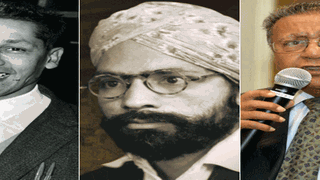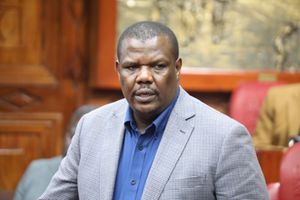
From left: Pio Gama Pinto, Makhan Singh and Manu Chandaria.
|Weekend
Premium
Kenyans of Asian origin have had a long history of good deeds and deserve respect
What you need to know:
- For more than a century, Asians have lived, worked and gained acceptance in the country.
- They run hospitals, schools and their charities have made a big difference in people’s lives.
Recent remarks at an election rally against an member of Parliament of Asian origin, Dr Swarup Mishra, point to our lack of understanding of the Asian community – and even more so, the frontline role they played in the freedom struggle. Names such as Pio Gama Pinto, Makhan Singh, Ambu Patel and Vidhyarti come to mind.
But the author of the anti-Asian remarks conveniently ignored that even the initial hostility and distrust that existed at independence between Asians and indigenous Africans has diminished – and Asians are now part of Kenya tribes.
With Africans rapidly engaging in trade, the economic gap between the two has narrowed. Today, the Asians who chose to remain behind after independence are accepted by Africans as loyal citizens of Kenya, not just as Indians or Pakistanis. These Asians regard Kenya as their only home and play a meaningful and purposeful role in the Kenyan society.
A majority of Asians who were in wholesale and retail business, and whose licences were withdrawn in the Africanisation process, went into manufacturing and are today the backbone of Industry in Kenya.
Building on the foundations of their parents but relying on their own entrepreneurship, many young Asians who at one time sought to establish their future outside Kenya have returned to Kenya and have excelled in the various businesses inherited from their parents or established on their own initiatives.
Kenyans of Asian origin who, along with their Ugandan counterparts, were unwelcome immigrants in the UK and Canada following the exodus are today considered an asset in those countries. The present British cabinet has an Indian – Rishi Sunak whose parents migrated to UK from Kenya in the 1960s’ — as Chancellor of the Exchequer. There is also the Attorney General Suella Braverman, whose father Chritie Ferandes wasca Goan who attended Dr. Rebeiro Goan School in Nairobi as late as 1967.
There is also the UK Minister for Home Affairs Preeti Patel who hails from Uganda. There are similar examples in Canada and USA. The most recent example in US is President Biden’s choice of Kamala Harris as his Vice President. Her mother is an Indian and father a Jamaican. She, too, has links with Africa having grown up in Lusaka, Zambia.
And we can go on to show how nations treat Asians in the diaspora.
Kenya’s struggle for independence
In a speech delivered by the then British Prime Minister David Cameron to the Indian diaspora in the United Kingdom on the occasion of the Indian Prime Minister Modi’s visit to the UK, Cameron paid tribute to the Indians living in Britain and made specific reference to those from East Africa for having contributed to the development of Great Britain in various sectors. Similar sentiments have been expressed by the Canadian Prime Minister Justin Trudeau.
And besides freedom fighters, Makhan Singh, Pio Pinto and Vidhyarti who took active part in Kenya’s struggle for independence, we have Apa Pant — India’s first Commissioner General to Kenya — who was appointed by Pandit Nehru a year after India achieved independence to sensitise Kenyans to also fight for their independence. He too played a significant part in Kenya’s struggle for independence perhaps far beyond diplomatic propriety as the then Colonial Secretary Lyttleton had observed. His was a pivotal role which he set about with zeal, and encouraged and supported Jomo Kenyatta and his colleagues in their struggle.
It was during Apa Pant’s term of office that Kenya’s fight for independence intensified and when the British banned the Kenya African Union, and sought to hunt down its leaders, he often gave them shelter and even hid them at his own residence, and provided them moral and financial support. This drew the wrath of the British. They raided his home and office inspite of its diplomatic sanctity, and succeeded in him being recalled to India after almost five years.
Today, less than 80,000 Asians remain in Kenya and constitute less than 0.02 per cent of today’s 45 million plus population. Their contribution in almost all sectors of the Kenyan economy and their support to various educational and welfare causes is most remarkable.
As in the UK and Canada, this miniscule group of Asians is an asset to be valued and nurtured. A majority of their families have been in Kenya since the turn of the eighteenth century. For them Kenya is the only home they have ever had. With increasing acceptance as loyal and trusted citizens of Kenya, they are destined to play a more significant role in Kenya’s future development.
There is a history to it.
As early as 1887 Allidina Visram contributed handsomely to schools and to hospitals in Kenya and Uganda – and even towards the building of the Anglican Cathedral and a mosque in Kampala. Allidina Visram’s son, Abdul Rasul, followed in his father’s footsteps, and as a memorial to his father established in 1918 the Allidina Visram High School in Mombasa.
First non-racial hospital
Karimjee Jivanjee who, although residing in Tanzania, contributed much to his community’s development in Kenya. So did Sir Yusufali Karimjee, A.M. Jeevanjee, and A.H. Khaderbhoy, who built a large hall – the Khaderbhoy Hall for the Municipal Council of Mombasa now being used as an outpatient dispensary.
The Social Service League was conceived in 1917 -18 with financial support from Allidina Visram, Suleman Verjee, Walji Hirji and Dinshaw Byramjee. It opened free dispensaries to provide medical attention for the poorer Asians. The only medical facility available to Asians and Africans at the time was a 36-bed wing in the Native Civil Hospital – formerly the King’s African Rifles Hospital. The hospital had no maternity ward with the result all Asian babies were delivered in homes with or without untrained midwives.
A Goan V.F. Saldhana who had an unpleasant experience in the Native Civil Hospital donated £4,000 towards the hospital fund. Ismail Rahimtulla Walji Hirji had left £60,000 in his Will for two rest houses and a donation to a hospital but because of a legal technicality it could not be used towards the Social Service League Hospital but was used to build an addition of an Asian wing at the Native Civil Hospital.
These came at a crucial time when hospitals other than the Kings African Riles Hospital and later King George V hospital, did not admit Asian or African patients.
The Ismailis had opened a dispensary in Mombasa as early as 1927. The Chandaria family subsidised since 1950 a number of clinics in the rural areas. Rahimtulla Trust supported a dispensary in Mombasa. A number of small hospitals also came into being. In Nairobi the Guru Nanak Hospital from donations from the Sikh community, the Jalaram Hospital and several small hospitals in the Sugar centres from donations by the Mehta, Madhvani, Kotecha and Hindocha families.
In Mombasa upon the death in 1942 of J. B. Pandya’s family donated Sh250,000 towards a hospital – named The Pandya Memorial Hospital. It started operation in February 1947. Dr. Karve gave up a lucrative practice to give free service at the hospital.
The Platinum Jubilee Hospital set up by the Aga Khan came up in 1958 and was the first non-racial hospital in Kenya. The hospital, now known as Aga Khan University Hospital, is the most modern and one of the best equipped hospitals in Nairobi and also houses a university.
Asian supported institutions
The MP Shah Hospital is second only to the Aga Khan Hospital and except for a brief initial stage, it is now open to all races. The hospital was opened in 1958 and was named after Saldhana, the Goan benefactor, and a wing was named in honour of the principal donor MP Shah. It is now the MP Shah Hospital.
Several private Asian trusts support medical and welfare institutions. Prominent among them are the Walji Hirji Rahemtulla Trust, MP Shah Charitable Trust, Rattansi Education Trust, Saleh Mohamed Trust, Chandaria Trust and Manu Chandaria Foundation, and Zarina and Naushad Merali Foundation and, more recently, Amara Charitable Trust, Dr. Choksey’s Albinism Foundation and Farja Cancer Support Trust launched on November 12, 2016.
Three of the six hospitals in Nairobi and two of the four in Mombasa are Asian supported institutions. Avenue Hospital in 1st Avenue Parklands is one such. It is run by two of Dr B.P. Patel’s sons. B.P. Patel was one of the first Asian surgeons in Kenya. Jalaram temple provides subsidised medical care at their centre in General Mathenge road and have recently built a Sh1 billion-plus hospital with modern facilities. It caters especially for the poor by providing free or subsidised medical care. Added to all this is the Sikhs’ Guru Nanak hospital in Pangani.
The Lions Eye Hospital in Loresho treats at very subsidised rates patients suffering from eye diseases. Some 25,000 patients have had their sights restored through cataract surgery. Through other privately sponsored projects similar number of patients have been treated by Asian doctors giving free services.
Both hospitals have benefitted from substantive donations from various Asian families and Rasik Kantaria of Prime Bank. Over 25,000 amputees have had Jaipur foot fitted at no cost and polio and others unable to benefit from a leg replacement have been given wheel chairs.
Manu Chandaria through his family’s Chandaria Foundation has supported among others the Chandaria School of Business at the United States International University, Chandaria Business Innovation and Incubation Centre at Kenyatta University, Chandaria Accident and Emergency Day Centre at Nairobi Hospital, Chandaria Medical Centre at Gertrude Garden Childrens Hospital, Chandaria Centre for Perfuming Arts at the University of Nairobi, Mabati Medical Center and also a Technical Institute at Mariakani, and several other projects including Scholarships for 100 students annually over the last 30 years, and 30 students for medium and small projects. These projects on average range from Kshs.50 million to Ksh .100 million.
We could go on. But certainly, no other community in Kenya has or is contributing any thing close to what this less than .02% of the population has contributed over the years, and continues to do so.
Mr Sharad Rao is a former Deputy Public Prosecutor




